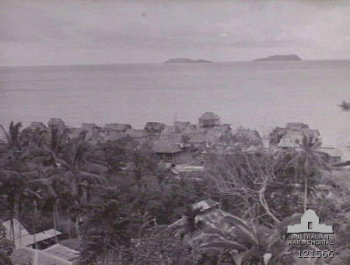![]() The Pacific War Online Encyclopedia
The Pacific War Online Encyclopedia
|
| Previous: Jerome | Table of Contents | Next: Jhansi |

Australian War Memorial #121566
Jesselton (Kota Kinabalu, 116.073E
5.967N) was founded in 1899 by the British
North Borneo
Company. Rubber
was produced in the hinterland and the port,
the largest in British North Borneo,
was a way station for
shipping
between Singapore
and Hong Kong. The town had the
only developed road system in British North Borneo, and a railway to
Weston on the eastern shores of Brunei
Bay.
Elements of 124 Regiment seized the area on 8 January 1942 against negligible resistance.
Jesselton Riot. On 9 October 1943, a violent riot broke out in the town. The ringleaders were ethnic Chinese, who had been badly treated by the Japanese, and who were apparently in contact with guerrillas in the area. The guerrillas were led by a Lieutenant Colonel Suarez, whose men killed some 40 Japanese. However, the revolt was swiftly put down by Japanese troops with air support, and the guerrilla movement was crushed by mid-December. The Kempeitai
arrested every ethnic Chinese they could locate, and mass executions
followed, including one incident in which 189 men and women were
executed.
The Kempeitai then turned their attention against the inhabitants of the Suluk Islands, a few of whose leaders had been
implicated in the revolt. On 13 February 1944, a force of Kempeitai
arrested a group of 58 Suluks from Mantanani Island after their chief
denied any knowledge of a Chinese guerrilla leader still at large. All
were tortured, and those who survived torture were beheaded. Two days
after the arrests, the Kempeitai returned to the island and killed every Suluk they could find. Out
of a population of 838 Suluks on Mantanani Island in 1941, only 288
were still alive when the war ended, of whom not more than 25 were
adult males.
The Kempeitai also killed the entire adult
male population of Dinawan and forcibly relocated the women and
children to a less productive island, where 27 starved. By 1945 the
population of Dinawan was reduced from 120 to 54 persons, with the
entire male population over the age of 16 exterminated. Similar
atrocities took place at Sulug and Udar. Although British investigators
did not believe the Japanese were deliberately seeking to exterminate
the Suluk culture, the massacres have been described as a genocide.
The town was not reoccupied by the Allies until 28 September 1945, six weeks after the Japanese surrender. By then the town had been devastated by Allied bombers.
References
ibiblio.org (accessed 2010-8-27)
The Pacific War Online Encyclopedia © 2007, 2009-2010, 2012 by Kent G. Budge. Index